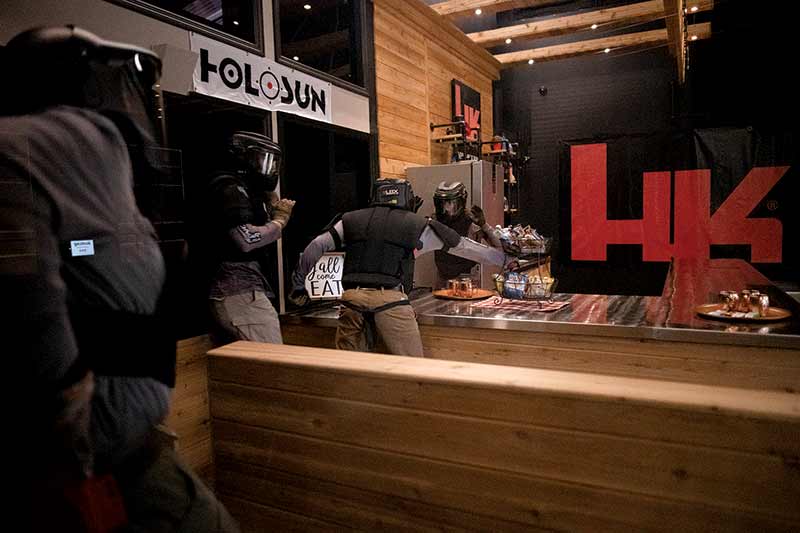Over the past three days I’ve been shot, stabbed, beaten, wrestled, molested by drunks, thugs and muggers, stabbed some more and killed about a dozen times. Ahhh … it’s been a truly glorious few days.
On the plus side, I did manage to ward off a few dozen seriously violent bad guys using escalating combinations of voice commands, lights and UTM sim firearms. Creative problem solving was the name of the game. One determined student pummeled his attacker with an outdoor trash can when his gun went out of action.
After perforating role-playing thugs with hundreds of “bullets,” something occurred to me. I used precisely one traditional range skill.
Thanks to the professionalism of the self-defense trainers at W.O.F.T. Self Defense outside of Orlando, Fla., I’m still alive and well, albeit with welts, bruises and various aches and pains. Sometimes that’s the price of valuable life lessons and I was more than happy to pay it.
Over the past decade or so, I’ve been to a couple of dozen firearms and defensive shooting courses. I can say without reservation I learned more practical self-defense skills over the past three days than all the others combined.
Did all those others teach me how to shoot? Absolutely. However, I’ve not yet seen anyone doing deep and immersive training with real defensive scenarios most likely to be encountered in everyday life. How many shooting schools have you sitting in a coffee shop, minding your own business, when two of six role-playing instructors break out into a full-on domestic fight? Maybe a weapon comes into play. Maybe it doesn’t. Or the “drunk” appearing to be sick next to your car suddenly pops up with a knife or gun? Ever thought about what you might do?
Learnings
The make-believe notion of being the cowboy in a white hat, casually standing back and shooting to save the day, was quickly destroyed. If only criminals would cooperate and accept the easy fate.
Situational awareness, or paying attention, is great. I’m all for a switched-on lifestyle. But if you think you’re so good at master-level awareness, you’ll be able to spot and solve any problem with a gun, you’re deluding yourself. We each face dozens of moments every single day when other people, or objects and structures capable of hiding an attacker, are close enough to allow one to be in our face long before we can react and bring a gun into the fight. Other defensive tools, both physical and mental, are a must.
A light is a powerful tool, and I need a simpler one. We ran dozens of scenarios in a dark parking garage ranging from a drunk harassing us to a planned two- or three-on-one mugging. Whether there was criminal intent, the light was a useful tool to help separate the annoying from the truly dangerous. When things got ugly, the light was a valuable tool not only to identify targets, but to distract, buy precious fractions of seconds, and sometimes escape. My current model has different intensities and modes. Forget that. I want one power level — high — and one button.
Leaving doesn’t feel very macho, but is often the right solution. Remember, as much as you may want to see yourself as society’s designated protector, you have a bigger obligation to come home to your family. That’s hard to do if you’re dead or spending the next few decades in jail as a result of getting mixed up in someone else’s altercation. Think long and hard before getting involved. The real story is far too often different from what first appearances indicate.
Explosive and committed action is a powerful strategy. By acting with vigor, you have a 0.25 to 0.50-second action/reaction advantage over your adversary. This can save your life.
Don’t settle for grabbing the “little gun” and stuffing it in a pocket before you run to Walmart or out to grab some milk. Those are likely your most statistically dangerous errands. If you’re going to carry, do it right.
That Range Skill?
Oh, and the one range skill I did use throughout the force-on-force shooting incidents? Malfunction clearing. While UTM-equipped firearms are more likely to jam, most malfunctions were a result of close quarters combat. Shooting while yanking your gun back to a retention position because Joe McThuggNoggins is lunging for it tends to cause a misfeed. Pulling the trigger with your muzzle jammed into an attacker pounding you into the pavement is another winning cause of a stuck gun. The list goes on — with a common denominator. Fighting with a gun at contact distance doesn’t allow for a proper Weaver or Isosceles stance and grip, and the risk of jams skyrockets, so be darn sure you learn how to instinctively clear your gun.
I’ve always figured malfunctions were unlikely in a self-defense encounter because quality modern ammo and guns almost always go bang. But the best gear may not work right in the middle of a close-quarters fight. At one point I ended up pistol whipping an instructor (wearing protective gear) in the head with a jammed pistol. Clearing a malfunction would have been a great option, but my support hand was holding his knife at bay. Yet another scenario I didn’t fully appreciate until it happened to me.
If you carry a gun for self-defense, by all means, learn how to shoot. “Range” skills will help when you’re shooting at high speed from awkward positions, even if you’re not planted in your official gunfighter stance at standoff distance. But be sure to consider some real scenario training to learn tools and strategies for problem solving, with or without that gun. The past three days changed my life, and it was only a taste of what I still need to learn.


